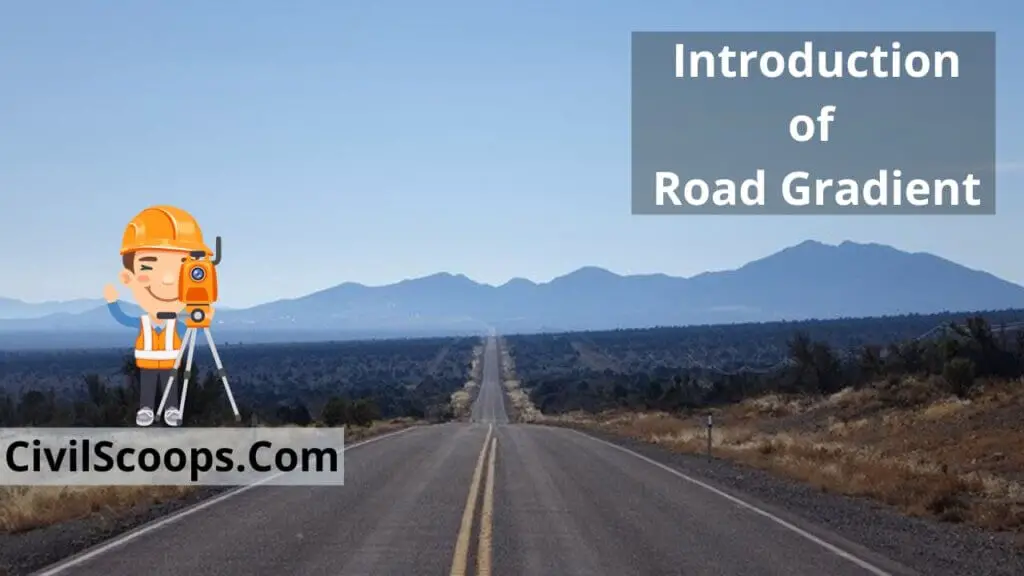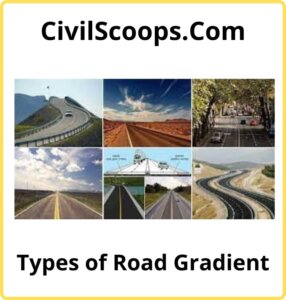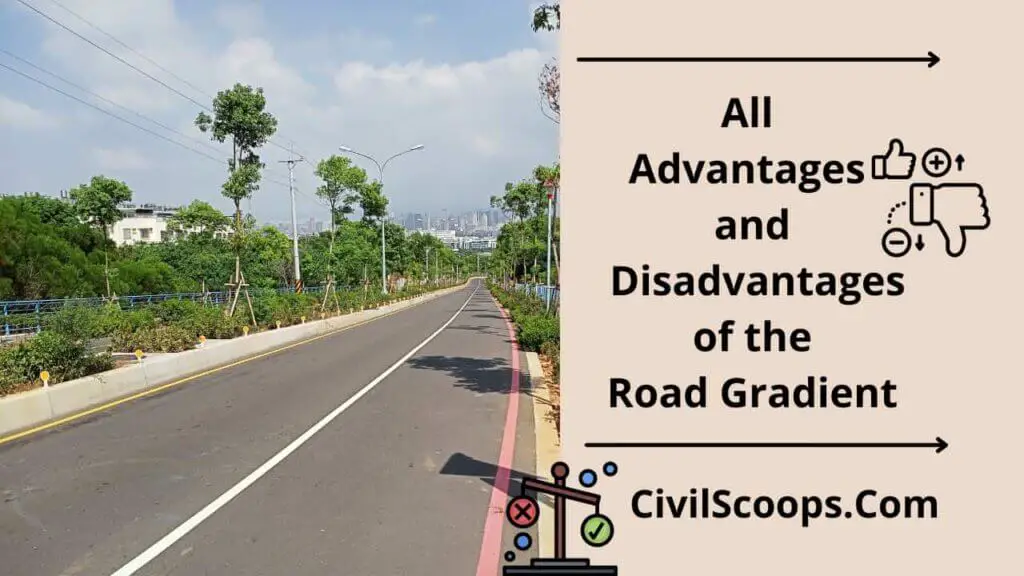Road Gradient | Type of Gradient | All Gradient Advantages and Disadvantages

Table of Contents
What Is Road Gradient?
The rate of rise and fall with respect to the length of the road is termed as gradient of the road. The road gradient is naturally expressed in the term of 1 in n term where 1 is the vertical unit and the ‘n’ represents the horizontal units.
So, in mathematically gradient + ( vertical / horizontal distances) X 100
Purpose of Providing Road Gradient
Here, the providing road gradient are as follows.
- The points or stations which are located, at different positions: to connect those points we need to use road gradient.
- For the drainage system of the road, we use gradient specially in the kerb portion.
- It neutralizes the process of cutting and filling in the construction of road.
- To create economic drain beside of any road.
Importance of Gradient in Road
Here, the importance road gradient are as follows.
- It is one of the most important parts of road construction. In every road gradient, we need to provide a proper gradient.
- Road gradient allows all the vehicles to go in vertical curves or steeper paths.
- To clean up the rainwater from the road: gradient carries an important role.
- A gradient is basically provided after finalizing the construction cost, practical problems, vehicle operation cost, etc are considered.
Effect of Gradients on Roads
Here, the effect of road gradient are as follows.
- By providing the road gradient we must consider the vehicle speed.
- The fuel consumption of the vehicles are higher in the gradient portion considering to the flat road.
- Due to high speed between heavy and light vehicles in the uphill and downhill portion, maximum accidents are happened.
Factors Affecting Gradient
Here, the factors of road gradient are as follows.
- Proper drainage required
- Type of road surface
- Nature of the ground surface
- Nature of the traffic
- Railway and road interaction
- Bridge approaches
- Safety required in the gradient
Road Gradient Recommendations as Per IRC
[su_table responsive=”yes” class=”rk”]
Nature of Ground |
Gradient |
||
Ruling |
Limiting |
Exceptional |
|
Plain or rolling terrain |
1 in 30 | 1 in 20 | 1 in 15 |
Mountainous terrain |
1 in 20 | 1 in 16.7 | 1 in 14 |
Steep surface |
1 in 16 | 1in 14.3 | 1 in 12.5 |
[/su_table]
Types of Road Gradient

Gradients are mainly categorized into six categories, those are-
1. Limiting Gradient: A limiting gradient is that type of gradient which is steeper than ruling gradient. This limiting gradient is mainly used in rolling terrain and hilly terrain. This gradient is also known as a maximum gradient. The limiting gradient is steeper than ruling gradient.
2. Ruling Gradient: A ruling gradient is that type of gradient which is used to make the alignment of the road. This is adopted widely because this gives maximum safety at minimum cost. It is only provided after a proper topographical study and traffic study. The ruling gradient is mainly obtained for the locality. The IRC recommendation for the ruling gradient is- In flat or rolling terrain- 1 in 30 Hilly terrain- 1 in 20
3. Exceptional Gradient: An exceptional Gradient is that type of gradient which is steeper than limiting gradient, this is used in only for a special situations. This gradient is adopted in unavoidable situations like mountainous terrain that’s why the gradient is steeper ad it causes more fuel requirement and frictional losses.
4. Average Gradient: The rate of fall or rise between two points along the road alignment is known as average gradient.
5. Floating Gradient: Floating gradient is a gradient where vehicles are moving smoothly with constant speed without using braking or other application. It also saves the energy of the machine.
6. Minimum Gradient: A minimum gradient is that type of gradient where we provide a minimum slope for the drainage purposes of rainwater. This gradient is mainly provided in the plain roads for drainage purposes of rainwater. The gradient value depends on the soil type, topographical condition, run-off, and other parameters. Generally, we provide 1 in 200 slope for the minimum gradient but in the cement concrete surface grade, it becomes 1 in 500.
7. Steeper Gradient: This type of gradient are very inconvenient for traffic movement because here all the traffic speeds are lesser in this gradient. In this type of gradient, we need a massive earthwork operation for construction. The IRC recommendation for this type of gradient is – In flat or rolling terrain- 1 in 20 In hilly terrain- 1 in 15
All Advantages and Disadvantages of the Road Gradient

Advantages of Rulling Gradient
- Ruling gradient is the desirable upper limit of the gradient in the road alignment.
- Ruling gradient is mainly done for the locality purpose usage.
- This type of gradient can reduce the accidents in the roads.
Disadvantages of Rulling Gradient
- This type of gradient needs a proper design by experienced engineers and it can only provide after a proper traffic and topographical study.
Advantages of Limiting Gradient
- The main advantage of the ruling gradient is to minimize the road construction cost
- Limiting gradient is steeper gradient provides a wonderful view.
Disadvantages of Limiting Gradient
- This is a steeper gradient so it is used for limited road length.
- Due to the steeper slope fuel consumption and maintenance is also increased.
Advantages of Exceptional Gradient
- Exceptional gradient is mainly done when a unavoidable situation arrived: this is the main advantage of the exceptional gradient.
- This type of gradient is limited; this should not exceed 100 meters in a stretch
Disadvantages of Exceptional Gradient
- Too many cutting filling operations are required to execute this type of gradient.
- It requires more labor cost than other ones.
Advantages of Minimum Gradient
- The main advantage of this gradient is proper drainage of rainwater from the roadway.
- For proper drainage system the longevity of the road is increased.
Disadvantages of Minimum Gradient
- Though is has some specific function but it requires some extra cost.
Advantages of Floating Gradient
- In this type of gradient a motor vehicle can move smoothly without using extra energy or applying brakes.
- This type of gradient reduces vehicular damage.
Disadvantages of Floating Gradient
- The number of accidents can increase due to more speedy transportation.
[su_box title=”FAQ” style=”default” box_color=”#333333″ title_color=”#FFFFFF” radius=”3″ class=”” id=””]
Road Gradient
Gradient is a measure of a road’s steepness—the magnitude of its incline or slope as compared to the horizontal. Most often presented as a percentage, the gradient of a climb will normally fall somewhere between 3-15 per cent.may 25, 2020
Giant Road Bike
Giant bicycles, as the biggest bike brand in the world, is also known as one of the best budget bike brands. It consistently gets high ratings in its mountain and hybrid bike categories. Giant is also known for giving a comfortable ride. Trek bicycles state that they are “the world’s best bikes” on their website.
E Road
Eroad is a fully integrated technology, road charging and services provider. We were the first company in the world to implement a gps/cellular-based road charging platform across an entire country.
Specialized Tarmac Sl7 Pro
$7,800. We designed the new tarmac to have the perfect blend of aerodynamics, light weight, and ride quality to deliver the ride of your life.
Gravel Road
A dirt road or track is a type of unpaved road made from the native material of the land surface through which it passes, known to highway engineers as subgrade material.
Tarmac Sl7 Pro
The tarmac just handles so well – it feels fast, comfortable and lightweight despite the wheels, it’s at home on climbs, descents and on the flat and would be perfect for any type of road riding, whether racing, chaingangs, club runs or just riding fast for fun.
Specialized Tarmac
Both models are priced at $12,000 which includes the top end sl7 fact 12r carbon frame. In this case, the build includes a full sram red etap axs drivetrain, roval rapide clx wheels, and a quarq power meter.
Supersix
The fastest lightweight bike we’ve ever made. The all-new supersix evo is a beautiful evolution of our classic race machine. We kept the light weight and telepathic handling of the award-winning previous version, and amplified the hell out of everything else.
Specialized Allez Elite
[su_table responsive=”yes” class=”rk”]
year |
2021 |
|
model |
allez elite |
|
size |
56cm |
|
frame material |
aluminum |
| weight |
19 lbs 3 oz |
[/su_table]
Aethos Specialized
Sadly the bike never went anywhere, but it struck me as wonderfully coincidental that i’m testing what’s claimed to be the world’s lightest production disc brake bike – the s-works aethos – and its weight? It’s 6.23kg, or 13lbs 12oz in old money.
[/su_box]
[su_note note_color=”#F2F2F2 ” text_color=”#333333″ radius=”3″ class=”” id=””]
Like this post? Share it with your friends!
Suggested Read –
- All About of Portland Cement Uses
- What Is a Spillway | Types of Spillway | Definition Spillway | Spillway Design
- What Is Tie Beam? | Tie Beam Details | Ties in Column | Tie Beam Design | Concrete Tie Beam | Tie Beam Reinforcement Details
- Types of Curing | Concrete Curing Time | How to Cure a New Concrete Slab | What Is Curing of Concrete | How Long Does Concrete Take to Dry | How Long Does It Take for Cement to Dry
- What Is Sheepsfoot Roller? | Characteristics of Sheepsfoot Rollers | Difference Between Padfoot and Sheepsfoot Rollers
- Monolithic Slab I Monolithic Definition I Monolithicfooting I Monolithic Slab Foundationl Monolithic Slab Foundation Design L What Is a Monolithic Slab L How to Form a Monolithic Slab
[/su_note]
Originally posted 2024-04-05 05:14:01.

